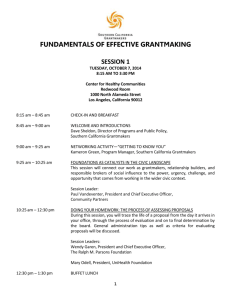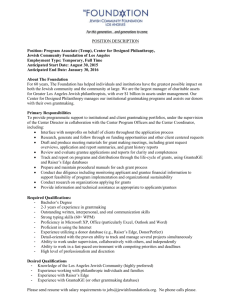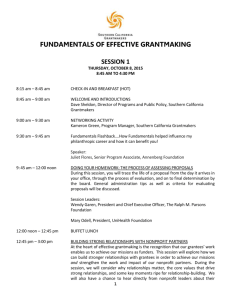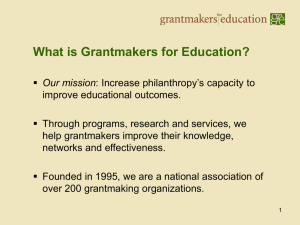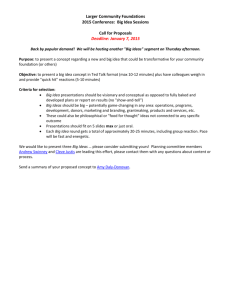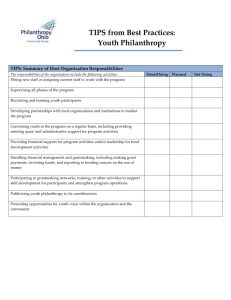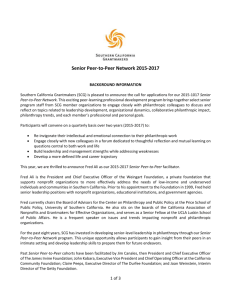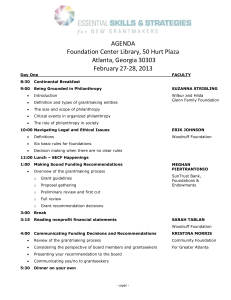THE BUSINESS OF GIVING
advertisement
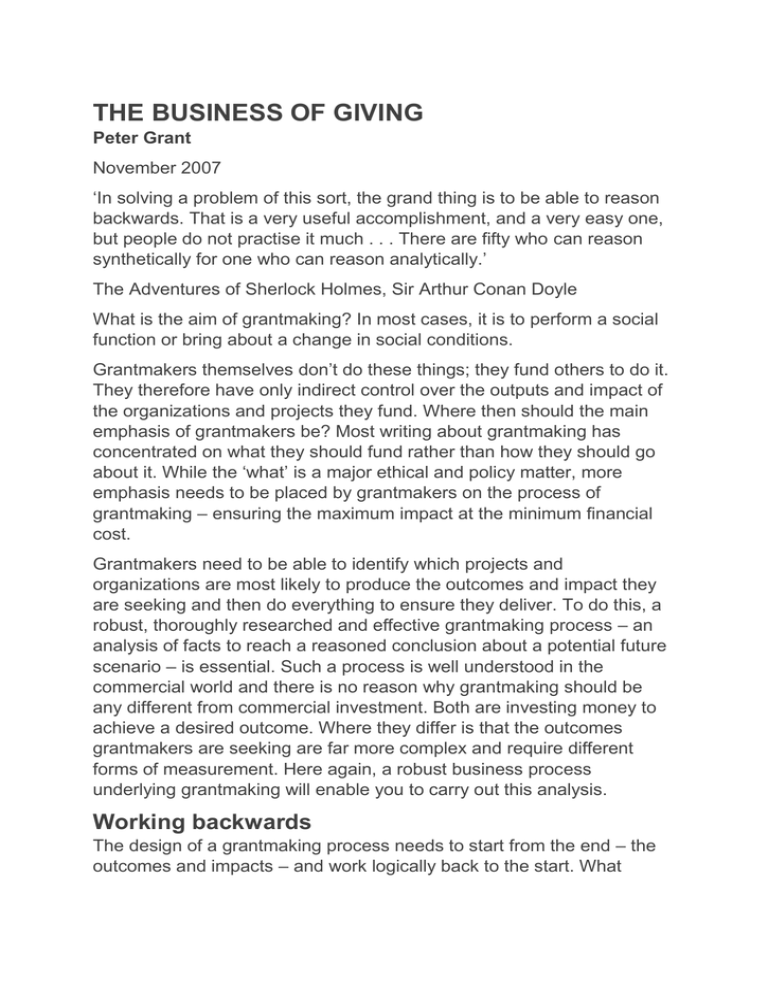
THE BUSINESS OF GIVING Peter Grant November 2007 ‘In solving a problem of this sort, the grand thing is to be able to reason backwards. That is a very useful accomplishment, and a very easy one, but people do not practise it much . . . There are fifty who can reason synthetically for one who can reason analytically.’ The Adventures of Sherlock Holmes, Sir Arthur Conan Doyle What is the aim of grantmaking? In most cases, it is to perform a social function or bring about a change in social conditions. Grantmakers themselves don’t do these things; they fund others to do it. They therefore have only indirect control over the outputs and impact of the organizations and projects they fund. Where then should the main emphasis of grantmakers be? Most writing about grantmaking has concentrated on what they should fund rather than how they should go about it. While the ‘what’ is a major ethical and policy matter, more emphasis needs to be placed by grantmakers on the process of grantmaking – ensuring the maximum impact at the minimum financial cost. Grantmakers need to be able to identify which projects and organizations are most likely to produce the outcomes and impact they are seeking and then do everything to ensure they deliver. To do this, a robust, thoroughly researched and effective grantmaking process – an analysis of facts to reach a reasoned conclusion about a potential future scenario – is essential. Such a process is well understood in the commercial world and there is no reason why grantmaking should be any different from commercial investment. Both are investing money to achieve a desired outcome. Where they differ is that the outcomes grantmakers are seeking are far more complex and require different forms of measurement. Here again, a robust business process underlying grantmaking will enable you to carry out this analysis. Working backwards The design of a grantmaking process needs to start from the end – the outcomes and impacts – and work logically back to the start. What characteristics in funding proposals suggest the grantseeker will be most likely to bring about the effects you are seeking? Once you have such a process, the task of deciding who to a give a grant to is far simpler. It also frees resources for the even more important task of grant management: helping ensure that the investments you have made actually produce results. It’s illogical for grantmakers to think that their job ends after awarding a grant. Until you decide to make an investment, the risk to you that things won’t work is nil. It’s only after you’ve made that decision that the risks arise. Effective grantmakers, then, need to focus their greatest resources (both staff and board/trustees) on the post-grant decision phase. Grantmakers’ business is funding This overemphasis on the ‘grant decision’ leads to the belief that the business that grantmakers are in is the area of work they fund – education, social welfare, the arts or whatever. This is a mistake. Grantmakers are in the funding business. It is their task to fund the work of others as efficiently and effectively as possible. Unless they want to be highly interventionist – and this requires very specialist forms of grantmaking such as venture philanthropy – they operate most effectively when they don’t interfere too much with what those delivering the service are doing. The mistake grantmakers make is to concentrate too much on the end product to beneficiaries and forget about their own internal workings as a funder. This mistake is all too common. Very often, a grantmaker’s board is made up of ‘sector specialists’ who know a lot about their subject and little about grantmaking. Even where the importance of process is recognized, there is a tendency for grantmakers to value the specialist contribution more highly than the operational one so that the specialists often overrule those who plan and manage the operational process. Equally, the governing board or trustees of a grantmaker should not think that their job is to take decisions about grants. Their primary job is to ensure the grantmaking organization is well run. Extending the commercial parallels Here again, I believe that grantmaking should recognize its kinship with business. If a business placed too great an emphasis on the ‘specialist’ role (the detail of the product they sell) rather than the wider process issues (planning, marketing, etc), either it wouldn’t be around for very long or it would remain a small, specialist organization supplying a niche market. Once one accepts that grantmaking is a business, it will become apparent that other business approaches are adaptable to the grantmaking world too. This helps to explain why the masters’ programme I head up is located in a major business school. It allows access to academics and professionals from the business world and interaction between our students and those engaged in business courses (for example when ‘teaming up’ to explore the world of investments). On the course, we look at significant areas of grantmaking policy and ethics, ‘fairness’ and diversity, but we also emphasize the management of grantmaking. We cover, among other things, risk management, project management, performance management and operations management theory. Operational process design There is space here to look at only one area that has been little discussed by grantmakers – operational process design. The concept of process design is well understood. It develops from an initial idea through appraising options and testing to the launch of the idea, product or service. It then governs how the process operates in action, evaluating performance and making improvements to reach a final design, after which the cycle restarts. This concept-design-test-evaluate-redesign model underpins every process from the manufacture of cars to grantmaking programmes. The key point is that is it possible to trace back all productive processes to a generic design, the supply network design, which can then act as a ‘blueprint’ for all future process design in that field. This is a critical concept for grantmakers. The processes they use can be illustrated diagrammatically and this mapping can form the basis for all the operational planning of a grant programme or an entire grantmaking organization. As an example, the grant programme design process that I introduced at the New Opportunities Fund enabled nearly a hundred separate grant programmes, in fields as different as individual grants for Second World War veterans and multi-million pound windfarms, to be set up, with all the required assessment, resource and risk management and other elements, within, potentially, a few days from agreeing the concept and answering key questions about the outcomes sought. Selecting the appropriate grantmaking model The desired impact of a grantmaking programme derives from the mission and goals of the grantmaking organization. This enables the grantmaker to define the outcomes they want to achieve and, in turn, the outputs they might expect to see if they are making progress towards them. The detailed grantmaking process or ‘model’ they then select should be the one most appropriate to achieving the intended results. This, in turn, will determine the inputs required. This is the most difficult part that few grantmakers do well – selecting the detailed grantmaking ‘model’ that will be most appropriate to reach the intended outcomes – because the process of doing so is insufficiently understood. Some examples Let me give three examples of model selection from my own experience. The New Opportunities for PE and Sport programme provides funds for new capital sports facilities in UK schools. It had a ‘fast-track’ element to provide some pilot projects to guide others in the design and operation of similar schemes. The process adopted in application and management information was highly detailed as the outcomes were extremely specific, especially the ability to complete a complex capital project in a short time-frame. The programme received significant criticism for the ‘over-bureaucratic’ nature of the information requested, yet this was essential if the programme’s outcomes were to be achieved. At the other end of the spectrum the Fair Share Trust was established to provide a ‘declining annuity’ (a total of £50 million over ten years) to 70 of the UK’s most deprived neighbourhoods. The outcomes were very broad, basically leaving the communities in those areas to make their own decisions about their needs. The process adopted in this case was to establish an ‘arms length’ charitable trust to manage the programme with few of the usual bureaucratic ‘compliance’ mechanisms in place. Asking the one key question In one case, we got the process wrong. The New Opportunities Fund Healthy Living Centre programme has resulted in over 300 highly innovative primary health projects in the UK. However, though we adopted a two-stage process for selecting these, often highly complex, projects we got the balance wrong. The programme had a large number of health-related outcomes and, in order to help us in our decision making, we requested far too much information for a first stage application. We should have concentrated on the really critical outcomes. In fact it may be true to say that a grantmaker really has to ask only one key question about a project: ‘if everything goes right with this, what difference will it have made?’ Grantmakers are always concerned to maximize the amount of resources they make available to grantees. However, if minimizing expenditure on administration simply means minimizing social impact, it is pointless. Grantmakers sometimes boast of how little they spend on administration when they ought to be examining how effective they are. Robust grant programme design processes will help establish operational performance goals that can, if necessary, be balanced against each other (for example, in this programme will it be more important to deliver results quickly or to keep costs to a minimum or to be flexible in responding to external change?). Such operational performance goals also suggest the things that grantmakers themselves should measure when trying to answer the questions ‘are we being effective in our grantmaking?’ and ‘are we getting better or worse?’ Something else the grant programme design process can emphasize is the extent to which decisions taken very early in planning will have an effect later on. In any process, the end product will depend very much on decisions taken at an early stage. Curiously, then, while early decisions are cheaper, they have a greater impact. Process doesn’t mean inflexibility But doesn’t an emphasis on process mean that grantmaking, which is essentially about people, will becoming straitjacketed and inflexible? Well, if it does, it means you’ve got the design of the process wrong. A well-designed process will do just the opposite. It will free up thinking time for the crucial human decisions by making the more straightforward tasks quicker and more reliable. The best businesses are extremely good at achieving this sort of balance. Their ‘agility of thinking’ is what marks them out from their competitors. They are able to take quick, informed decisions that sometimes significantly alter what they are doing or how they do it precisely because they are underpinned by clear, welldocumented and robust processes that positively enable this kind of agility. A well designed process is the liberator of the mind not its inhibitor. As another great fictional detective said: ‘I have the order, the method, and the psychology. There, I admit it. I am the best. I am Hercule Poirot.’
